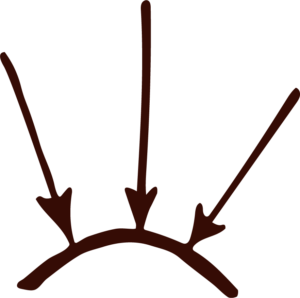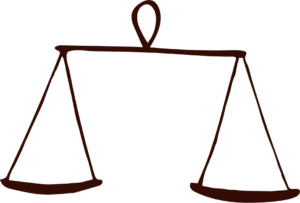Dear all,
I’d like to share with you an article I wrote for our Dutch audience at Methodoflevels.nl, explaining the levels proposed by Powers in the perceptual hierarchy and connecting the experience of control or loss of control at each level.
I’ve translated the article to share these ideas with you and hopefully spark some discussion and ideas on how to move forward with these ideas. Please let me know what you think, if you disagree (experience error) at any point, or have ideas how to improve this overview.
The text is based on the poster I presented at last year’s IAPCT conference in Manchester. The drawings are mine, to fit the petroglyph style of our site. Please bear in mind that the English translation is just that, a translation. I might have overlooked some details or a native speaker would have a more fluent way of expressing the nuances.
Eva
What are you experiencing now?
Experiences in the hierarchy of perceptions
Eva de Hullu, PhD
Translation of: https://methodoflevels.nl/artikelen/wat-ervaar-je-nu/
In the Perceptual Control Theory we assume that control is hierarchically organized. You build your own experience in layers of increasing complexity. Powers first described 9 layers in his book, which he later expanded to 11 levels. You should see these levels as a hypothesis of how the control system is built up in humans. It could well be different, and we still have little evidence. But thinking according to these levels helps to understand many of our experiences, and from that motivation I like to share this knowledge.
Below I describe the levels based on the ideas of Powers, supplemented with my own descriptions of how you can translate those ideas into the experience of control and loss of control, and how you can focus on this level as you do in MOL conversations. Note that you can seldom focus purely on a particular layer. The layers around it are often involved in the peripheral attention and the layers underneath are always part of the perception from a certain layer, by the way layers are built (see https://methodoflevels.nl/artikelen/theorie/pct/hierarchische-organisatie-van-percepties/)
From the lowest level (level 1) we go up. Each time the step is from a multitude of perceptions to a single unit at the level above: many to one. Upward, the duration of the experience continues to increase, from less than a millisecond at the lowest level to lifelong at the highest level. From level 1 to 3 you only experience the here and now. Note that language only comes into play at levels 6, 7 and 8. The experience of an ‘I’ is limited to levels 9, 10, 11. Below that (levels 1-8) the experience is more like: it happens in me, or there is, it happens.
Level 1. Intensities

The level of the intensities is the bottom level of the perceptual hierarchy. This way of experiencing is limited to the intensity of sensory information. At this level you receive feedback from within your environment or from your internal organs.
Examples are the experience of muscle tension, loudness of sound, heat, cold.
You experience control at this level as an experience of contact with the physical (outside) world. “To feel grounded”. And the loss of contact with the physical world if you lose control of this level.
You can focus on this level by asking to focus on places where your body makes contact with the environment: You feel your buttocks on the seat, your feet on the floor. You can also focus on the physical inner world, for example when you experience tension in your shoulder.
Level 2. Sensations

From a combination of intensities you can experience different sensations. You can view sensations as a set of sensory information.
Examples are the taste of lemonade (sweet and sour at the same time) or feelings involving one sense, such as tension, pain.
Control from this level can be experienced as a sensation: a particular taste, the feeling of touch. You experience loss of control as numbness or an inability to bring home your sensory information: loss of taste, smell, sight.
You can focus on this level by asking: What are you experiencing now? What do you feel now? You hear, for example, that there is a kind of 'pressure’, that something hurts, that something relaxes.
Level 3. Configurations

From this level of perception you experience certain configurations of sensations.
Examples are objects, such as a chair, or emotions, such as anger, without already having a name or meaning. You can see emotions as a combination of sensations, in which different sensory experiences are combined.
You experience control on this level when there is order, there are patterns, forms. Loss of control means that you do not recognize order, that objects have no unity.
You can direct attention to this level by asking: What are you experiencing now? Which emotion do you experience? You can get answers like: I see a kind of big black spot, There is a kind of knot, I feel anger everywhere.
Level 4. Transitions

When you experience how one configuration changes into the next, you experience transitions: moving, changing configurations.
Examples are the experience of time, movement, change.
You experience control at this level as perception of change, passage of time or processes, movement. Loss of control can mean that you have no idea of time or movement, that there are no transitions.
You focus your attention on this level by asking: What is changing now? How does configuration X transition to configuration Y? What moves in you? You will get answers like: It flows, it changes.
Level 5. Events

The perceptions on levels 1-4 can be experienced together as an ‘event’. This level unites experience in an event.
Examples include a sip of coffee, a door that opens, a heart pounding.
You experience control at this level as experiencing that something is happening. Loss of control would then be that you have no idea that something is happening. That you have no experience at all.
You focus on this level by asking: What is happening now? What are you experiencing now?, or referring to what you see happening: You swallow. You laugh.
Level 6. Relationships

From this level you establish relationships between underlying perceptual experiences. You experience how perceptions are related.
An example is the experience of the taste of coffee with the feeling of coffee. The position of the mug on the table. The sound of slamming with the door.
You experience control at this level as experiencing a relationship, cohesion. You know how something is connected in space, time, or process. There is an understanding of cause and effect, the experience of causality begins here. Loss of control means that you no longer know what it has to do with each other, you lose the sense of cohesion.
You can focus on this level by asking about the relationship between experiences. Is the feeling greater or less than X? Is it more or less? Is it above or below? Next to or opposite? What is the relationship between X and Y?
Level 7. Categories

From this level you can divide underlying perceptions into categories that share properties.
You will experience, for example, cats, birds, food, people, animals.
At this level, everything is black and white. It is either a cat or not a cat.
You experience control at this level as being able to distinguish. You are sure that something belongs to a certain category, type, class. Loss of control at this level means that you are unable to distinguish or classify anything. For example when you first encounter a platypus and cannot bring the animal home.
You can focus on this level if you ask for concrete perceptions with their similarities and differences. What else is there? Is X different from Y? You hear, for example: It is not really a hole, more a tunnel. Yes, a tunnel. Or: [a certain word or image] comes to mind.
Level 8. Sequences

From this level you experience perceptions as a sequence, with a fixed order in time, place or process.
Examples of sequences are the experience of a melody, a route, a sentence.
You experience control at this level as predictability, orientation in space and time. For example, if you walk on a main road, the next step you’ll make is obvious. At this level it also seems as if you are guided by the environment, as in a stimulus response model. You follow the road, you carry out the step-by-step plan, you let yourself be taken by what comes your way. Loss of control at this level is the experience of disorientation and unpredictability, not knowing what follows: Where am I? Where did I go?
You focus on this level by asking: What is going through you now? What comes to mind now? What else is there? Continue … You will hear experiences like: I go with the flow. It takes me to…
Level 9. Programs

From this level you will experience a structure of tests and selection points about the underlying sequences.
It is as if you end up on a crossroad from a main road: what do you choose now?
Examples of experiences at this level are following a recipe, coming up with a plan, making a choice, writing a paragraph.
You experience control from this level as being able to make a choice, smoothly devising or executing a plan. You choose your target and shoot. You know that what you are doing is a logical, appropriate, correct step. This is the level of I need to do something: in the case of X, do Y. You experience loss of control as indecision, not knowing what to do, not being able to choose.
You focus on this level by asking: What makes you say or think this? What does ‘making a mess’ look like? When you see this in front of you, what do you think? What stops you? For example, the answer could be: I have to stop … I don’t know what to do! I have doubts about X. It seems as if I have to choose between …
Level 10. Principles

From this level you experience fundamental principles, rules, values, beliefs. From this level you give direction to the underlying programs.
Examples are: Do no harm. Protect nature. Take care of yourself. Each principle can be translated in various programs, but it is often difficult to articulate the principle itself. It is more an intuitive knowing or feeling whether something is good or not. It is the experience of quality, as the cook knows that the soup is ready and the teacher knows that a child understands something. You can feel it.
Control from the level of principles is the experience of quality, that something is of value. That it is good, it is beautiful, that you understand it, that it is important. You experience what you want. Loss of control feels like a loss of meaning, you don’t know what is important or what you want.
You can focus on this level by asking: What makes this important to you? What does this mean to you? Why do you make that choice? The answers you get are more vague than those of programs: it feels good. It feels wrong. This is important to me, I feel this is what I want.
Level 11. System Concepts

If you can experience a combination of principles as a unit, as a coherent organization, you do so from the level of the system concepts.
You experience, for example, your identity, personality, your world view. You can also experience a comprehensive theory such as PCT as a system concept.
Control from this level feels like something is true. Something fits with your worldview, with you, with the system concept from which you consider everything. For example, you can experience: This is who I am. This is the truth. This is how it works. Loss of control at this level is an existential crisis. You no longer know what is true or who you are. Your world is falling apart.
You can focus on this level by asking: What does this principle mean to you? Or you ask how you combine different principles. What is it like for you to see those two principles at the same time? A good parent (system concept) leaves her child free (principle) and protects it (principle). You are there when you hear: this feels true! It feels like a whole! This is who I am!
Level 12.
Level 12 has not been described by Powers himself. He does not deny the possibility of this level existing, but he did not name it from his own experience.
At level 12, if you follow the line, you would experience a combination of system concepts together as one. This should also apply to system concepts that appear contradictory or incompatible at their own level. For example, the world views from different religions, or multiple personalities, that you would experience as a unity.
This experience of unity is reflected in texts about meditation, Buddhist texts, philosophical texts and under the influence of psychedelics. At this level you can experience how everything is one, whereby the experience of the self also disappears. Before we know more about it, this level has the status of hypothesis even more than the other levels.
![]()
Text and drawings by Eva de Hullu, 2020.
This work is under a licensedCreative Commons Attribution-NonCommercial-NoDerivs 4.0 International License.
Read more about the hierarchy
https://methodoflevels.nl/artikelen/theorie/pct/hierarchische-organization-van-percepties
https://methodoflevels.nl/artikelen/opinie/minder-doen-met-principes/
Literature
Descriptions based on the following sources:
De Hullu, E. (2019) Exploring the Control Hierarchy. Poster presented at the annual conference of the international association for Perceptual Control Theory, Manchester, UK.
Marken, RS (2002). More mind readings: Methods and models in the study of purpose. New View Publications.
Nickols, F. (2016) Levels of HPCT https://nickols.us/LevelsofHPCT.pdf
Pattee, HH (1973). Hierarchy theory: the challenge of complex systems. George Braziller, New York, 1973.
Powers, WT (1973, 2005). Behavior: The control of perception. Benchmark Publications
Powers, WT (1998). Making sense of behavior. Benchmark Publications
Runkel, PJ (2003). People as Living Things: The Psychology of Perceptual Control. Living Control Systems Publishing